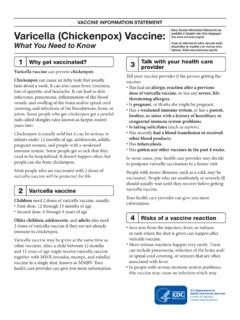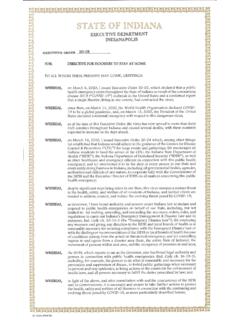Transcription of Implementation Handbook: Standard for Automatic …
1 OECD 2017 1 Standard for Automatic Exchange of Financial information in Tax MattersIMPLEMENTATION HANDBOOKS econd editionStandard for Automatic Exchange of Financial information in Tax MattersImplementation HandbookSECOND EDITIONnTablE Of COnTEnTsn2 OECD 2017 Photos credits: OECD 2018 You can copy, download or print OECD content for your own use, and you can include excerpts from OECD publications, databases and multimedia products in your own documents, presentations, blogs, websites and teaching materials, provided that suitable acknowledgment of the source and copyright owner(s) is given.
2 All requests for public or commercial use and translation rights should be submitted to Requests for permission to photocopy portions of this material for public or commercial use shall be addressed directly to the Copyright Clearance Center (CCC) at or the Centre francais d exploitation du droit de copie (CFC) at document, as well as any data and any map included herein, are without prejudice to the status of or sovereignty over any territory, to the delimitation of international frontiers and boundaries and to the name of any territory, city or cite this publication as:OECD (2018), Standard for Automatic Exchange of Financial information in Tax Matters - Implementation handbook - Second Edition, OECD, OECD 2018 3nTablE Of COnTEnTsnTable of contentsBackground and introduction.
3 6 Part I: An overview of the steps to implement the Standard ..12 Requirement 1: Translating the reporting and due diligence rules into domestic law, including rules to ensure their effective Implementation ..13 Requirement 2: Selecting a legal basis for the Automatic exchange of information ..41 The legal instrument ..41 Requirement 3: Putting in place IT and administrative infrastructure and Collecting and reporting the information ..462. Receiving the information to send ..483. Transmitting and receiving information .
4 49 Requirement 4: Protect confidentiality and safeguard data ..52 Part II: Overview of the Common Reporting Standard and due diligence rules ..56An overview of the Common Reporting Standard ..56 Chapter 1: Reporting Financial Institutions ..57 Step 1: Is it an Entity? ..57 Step 2: Is the Entity in the Participating Jurisdiction? ..58 Step 3: Is the Entity a Financial Institution? ..60 Step 4: Is the Entity a Non-Reporting Financial Institution? ..60 Chapter 2: Accounts which are Financial Accounts and therefore need to be reviewed.
5 62 The general rule and the more specific categories ..62 Excluded Accounts ..63standard for Automatic Exchange of financial account information in Tax MattersImplementationHandbook4 OECD 2018nTablE Of COnTEnTsnChapter 3: Financial Accounts which are Reportable Accounts ..65 Reportable Accounts by virtue of the Account Holder ..66 Reportable Accounts by virtue of the Account Holder s Controlling 4: Due diligence procedures ..72 The split between Preexisting Accounts and New Accounts ..73 Chapter : Due Diligence for Preexisting Individual Accounts.
6 74 Chapter : Due Diligence for New Individual Accounts ..81 Chapter : Due Diligence for Preexisting Entity Accounts ..84 Chapter : Due Diligence for New Entity Accounts ..90 Chapter : Other definitions and general due diligence rules ..96 Chapter 5: The information that gets reported and exchanged ..99 General rules ..103 Chapter 6: Treatment of trusts in the CRS ..104 Chapter : Basic features of a trust ..104 Chapter : Determining whether the trust is a Reporting Financial Institution or an NFE.
7 106 Chapter : The treatment of a trust that is a Reporting Financial Institution in the CRS ..107 Chapter : The treatment of a trust that is a Passive NFE ..112 Part III: The Standard compared with FATCA Model 1 IGA ..126 Annex I CRS-related Frequently Asked Questions ..146 OECD 2017 5nTablE Of COnTEnTsnBACKGROUND AND INTRODUCTION Standard for Automatic Exchange of financial account information in Tax MattersImplementationHandbook6 OECD 2018nbaCkgrOunD anD InTrODuCTIOnnThe purpose of the CRS HandbookThe purpose of the CRS handbook is to assist government officials in the Implementation of the Standard for the Automatic Exchange of Financial Account information in Tax Matters ( Standard )
8 And to provide a practical overview of the Standard to both the financial sector and the public handbook provides a guide on the necessary steps to take in order to implement the Standard . Against that background, the handbook is drafted in plain language, with a view of making the content of the Standard as accessible as possible to readers. The handbook provides an overview of the legislative, technical and operational issues and a more detailed discussion of the key definitions and procedures contained in the Standard .
9 This second edition of the handbook is intended to be a living document and will be further updated and completed over time. Changes reflected in the second edition of the handbook provide additional and more up-to-date guidance on certain areas related to the effective Implementation of the Standard . This includes revisions to sections pertinent to the legal framework for Implementation of the AEOI, data protection, IT and administrative infrastructures as well as compliance measures.
10 more clarity has been provided in the trust section of the handbook relation to the identification of Controlling Persons. The objective of the handbook is to assist stakeholders in the understanding and Implementation of the Standard and should not be seen as supplementing or expanding on the Standard itself. Cross references to the Standard and its Commentary are therefore included throughout the document. The page numbers refer to the pages in the consolidated second edition of the and Introduction OECD 2018 7nbaCkgrOunD anD InTrODuCTIOnnBackground to the creation of the Standard for Automatic Exchange1.













